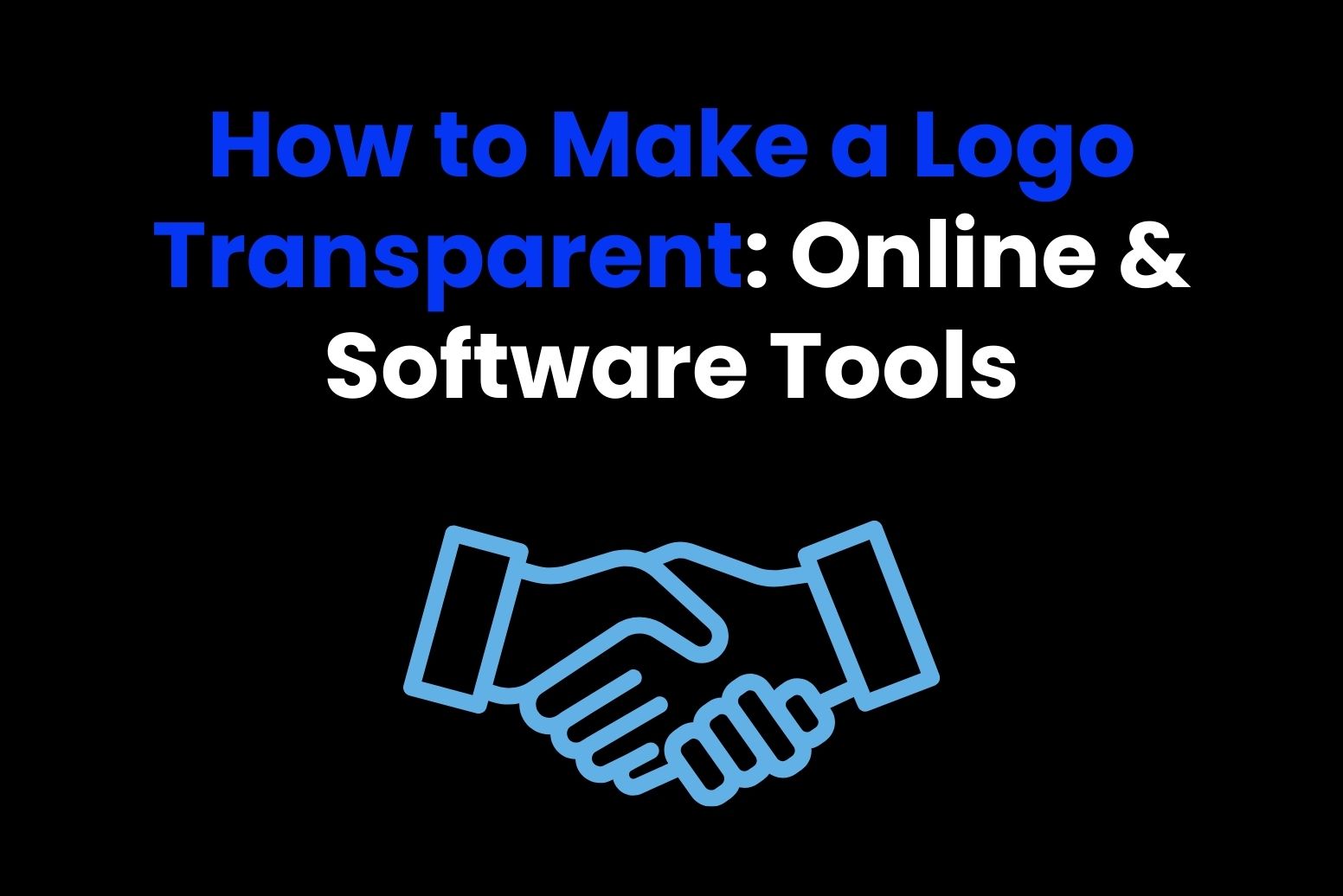Logos are the face of a brand, and the more transparent a logo, the more versatile and professional it is. Transparent logos are very important for branding, web design, and product packaging so that they blend well with various backgrounds. This article will be a step-by-step guide on how to make a logo transparent using online tools and software, including the innovative Arvin AI, to help you achieve a sleek, professional look.
What is a Transparent Logo?
A transparent logo has no background, meaning that it is able to become an integral part of any surface or design. Unlike traditional logos with solid color backgrounds, a how to make a logo transparent ensures focus only on the design elements by maintaining text, icons, or symbols.
Difference Between Transparent and Non-Transparent Logos
- Transparent Logos: The background is removed or set to a layer of transparency and therefore usually exported in formats like PNG.
- Non-Transparent Logos: Background is solid or patterned, making them less adaptable across various media.
Importance of Transparency for Modern Digital Branding
In today’s digital world, a how to make a logo transparent logo is indispensable for:
- Website Design: Ensuring logos adapt seamlessly to various sections and color schemes.
- Marketing Materials: Simplifying placement on posters, brochures, and advertisements.
- Social Media: Creating cohesive and polished visuals across platforms.
- Product Packaging: Elevating branding by integrating logos into designs without clashing with other elements.
Visual Examples
Adding an image or mock-up would serve to compare and contrast the following:
- Transparent Logo on a Website Header: Logo is fluid, not at all jarring.
- Non-Transparent Logo Example: white solid box clashes with dark background.
Why Would You Need a Transparent Logo?
That is why the transparent logo is a powerful technique in marketing which gives opportunity to succeed in creation of one and laconic, but at the same time, versatile brand image. These are the specific advantages which this type of logo offers and they make sure that it works well under different media and branding usage. The following are the points arguing how to make a logo transparent and why a transparent logo is important as per our research:
Flexibility in Various Media
A transparent logo provides unmatched flexibility, making it suitable for use across a range of platforms. It fits easily into headers, footers, and interfaces without disturbing the visual harmony of the design on websites and applications. For print materials, like business cards, brochures, or posters, the how to make a logo transparent background ensures the logo sits flush with the rest of the layout. It makes it easy to work with for the designers that would wish to give the project a professional touch across the different mediums.
Integration with Different Background Colors and Textures
One of the advantages of a transparent logo is that it can be overlapped on any background, regardless of color or texture. Unlike typical logos with fixed backgrounds, a translucent version allows for seamless overlay, whether on light, dark, textured, or gradient surface designs. This feature ensures clarity and legibility of your logos while complementing the corresponding design elements of the overplayed background.
Professional Appearance and Brand Consistency
A transparent logo makes your brand look more professional. Removing unnecessary background elements focuses attention on the core design of the logo itself, giving it more impact. Using it consistently across various media helps to reinforce brand identity in a polished and unified appearance.
Use in Promotional Materials, Social Media Profiles, and More
Usually, in making promotions, logos need to adapt for various formats and designs. One transparent logo can quickly get placed on merchandise, say, on a t-shirt or mug or banner. This likewise can be done on a social media page where creative placement may go through profile pictures, cover images, or post graphics.
Introducing Arvin AI for Logo Transparency
Arvin AI is an extremely quick tool that enables a person how to make a logo transparent easily. It is a crucial procedure for graphic work and incorporated operations. Its advanced machine technology guarantees that Clone BG has had background removal that is as clean and quick as is possible, in top quality. When you need to view your logo to use it in the Internet, on products or in advertisement it is an ideal unlinked application that makes your logo transparent and gives you more professional results.
Key Features of Arvin AI
- AI-powered background removal: The detection of the background of logos is fully automatic by using advanced artificial intelligence by Arvin AI.
- Fast processing: Arvin AI ensures quick processing of logos, thus perfect for designers and businesses requiring quick turn-around time without sacrificing quality.
- User-friendly interface: With its easy-to-use and navigate platform, Arvin AI is easily accessible to both beginners and professional users.
- Advanced functionality for designers and businesses: Arvin AI is ideal for businesses aiming to boost their brand’s exposure through the readying of logos on all digital and print mediums.
- Seamless integration with other design tools: Arvin AI can seamlessly work with other graphic design tools that can easily import and export files.
Steps in Using Arvin AI to make your logo transparent
Step 1: Go to the Arvin AI Website
Open a browser window and open Arvin Logo Maker for designing your new, unique, and how to make a logo transparent company logo.
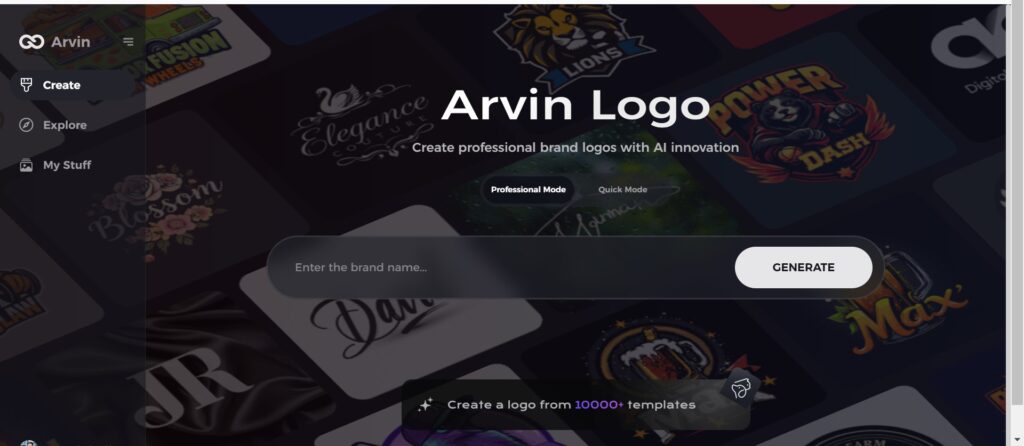
Step 2: Fill Up Your Company Details
Just enter the name of your company and pick its category and ask for transparent logo. All the details enable the AI to find the designs that would serve your needs and are representative for your company.
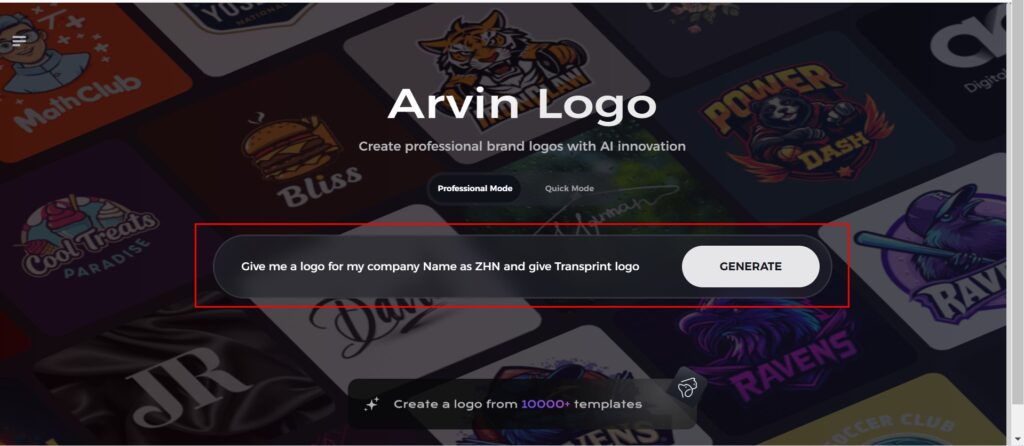
Step 3: Choose Your Industry
Pick an industry that best suits your business. This process guarantees the AI is making styles and themes that align best with your brand’s core value and niche in the market.
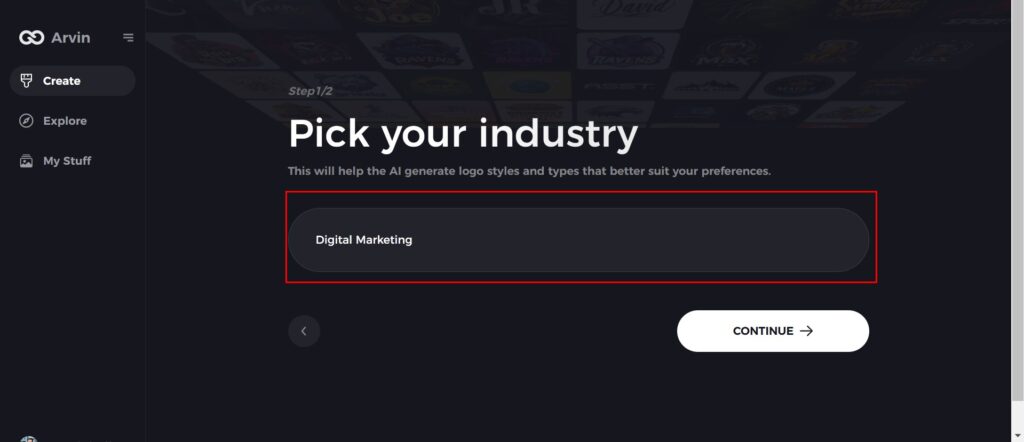
Step 4: Style Select
Pick a design style from the available ones. Leave it to “no style” if you’d want the AI to surprise you. The selected style shall provide a guideline for the final logon designs created.
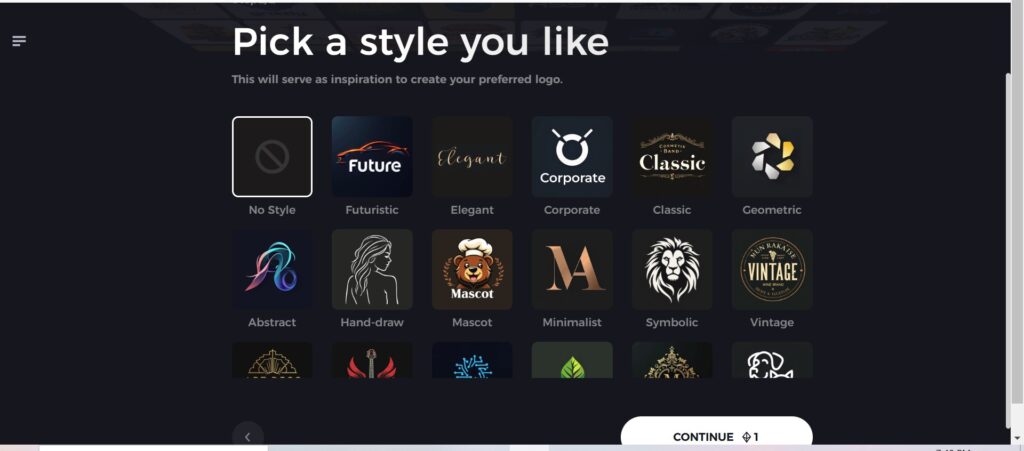
Step 5: Explore Logo Concepts
Arvin AI will produce different types of logo designs according to the information provided. Simply scroll through the suggestions for a design that matches your brand identity.
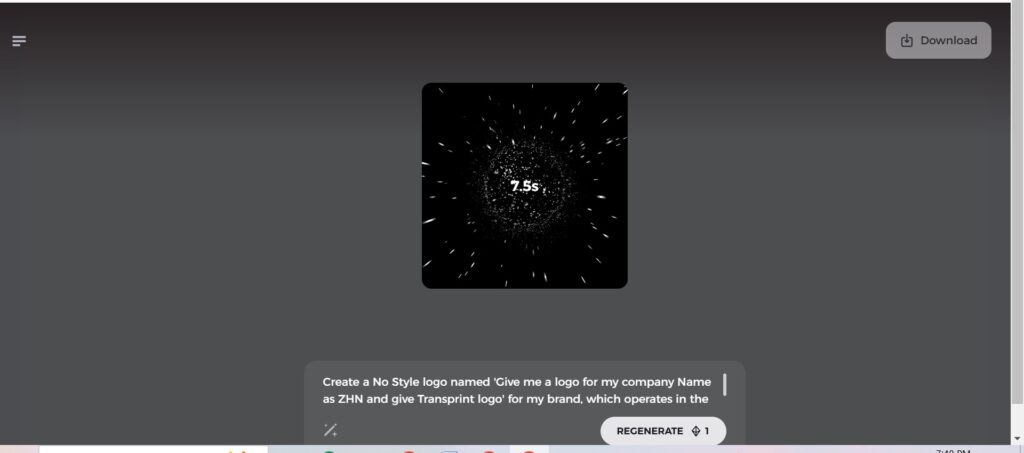
Step 6: Finalize the Logo
Fine-tune the chosen logo by adjusting colors, fonts, and icons to meet your brand personality and aesthetic. This way, your final logo is perfect and completely in line with your brand’s personality and style.
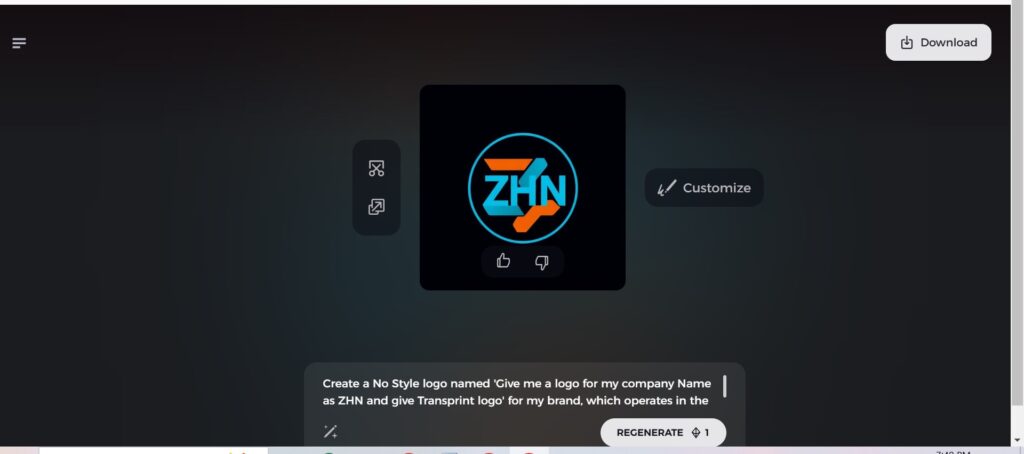
Step 7: Download Your Logo
Once satisfied with your final design, download your logo in versatile formats such as PNG or SVG that would be perfect for various media. Websites, social media, print, and so much more-these logos will give a professional look across every platform.
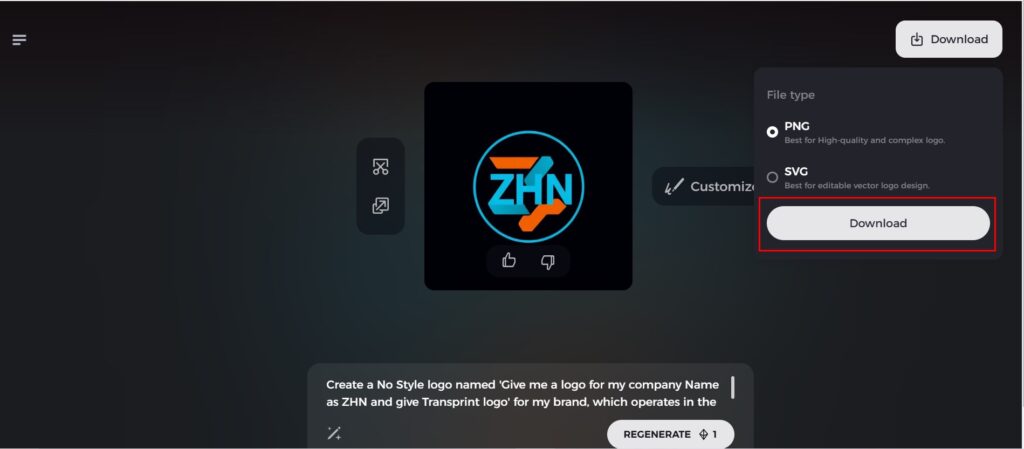
Tips for Creating a Transparent Logo
The ability to how to make a logo transparent is crucial in flexible branding since a transparent logo background prevents a disturbing background when printed on different media. Find below key tips on the creation of a quality transparent logo:
Best File Formats for How to Make a Logo Transparent
When making a transparent logo, it is also essential to use the correct file format for maximum transparency and high image quality.
- PNG (Portable Network Graphics): This is the most used file format for logos having the transparent background. PNG completely supports the transparency and has clear image quality without any kind of background noise or artifact. PNG is best for websites to provide a clean logo impression on any background.
- SVG (Scalable Vector Graphics): SVG is a vector format that supports transparency, making it ideal for logos that require scale across various devices or print sizes without losing quality. SVG files are editable, hence the logo can be resized and there will be no degradation.
How to Maintain the Quality and Resolution of Your Logo
Keeping your logo quality and resolution maintained is very important to ensure your logo appears crisp and professional on different platforms.
- Use High-Resolution Originals: Do not start with a low resolution that might pixelate on the output. For print, it is recommended to work with logos at a minimum of 300 DPI.
- Avoid Scaling Up Raster Files: If you made your logo in a raster format (like PNG), do not scale it up too much. Loss of quality and visible pixilation will result. Consider the use of vector formats (such as SVG) for logos to be frequently resized.
Things to Avoid When Creating a Transparent Logo
While designing a transparent logo, certain disadvantages may affect the final product. Be careful of the following:
- Low Contrast Colors: Translucent logos suffer if printed on to backgrounds that are too similar in color. Avoid colors that merge with your background because they make it quite hard to spot your logo.
- Complex Backgrounds: A logo should glow through any background. Avoid detailed or intricate designs having complex elements in the background as they may collide with the transparency and cause an alteration of focus away from the logo.
Advanced Techniques for Transparent Logos
Once you are keen on the basic how to make a logo transparent work, you can advance to techniques that help raise the level of your design. The techniques help in creating logos that are of such quality but versatile and impactful in all the targeted media.
Using Vector-Based Formats (SVG) for Scalability
One of the main advantages that vector formats, like SVG, provide is scalability. While raster images can only be displayed at one pixel density, vector logos draw images as mathematical equations that can scale infinitely without degradation in image quality. For this reason, SVG files are well suited for any kind of logos that must appear in many different formats from small web icons to large print formats. The scalable feature of SVG files guarantees your logo will look sharp in all sizes.
Creating Logos with Gradients or Shadows on Transparent Backgrounds
Adding gradients or shadows to a transparent logo can create depth and dimension, giving the design a modern and dynamic feel. Gradients, if applied subtly, can bring visual interest without overpowering the logo. However, avoid using complex or heavy gradient effects, as they can make your logo appear cluttered on transparent backgrounds.
Optimizing Transparent Logos for Web and Print Usage
There are different things that need to be considered when optimizing your logo for web and print. When it comes to web usage, file size would be one important factor. You would want to avoid having large image files as these can slow your website, thus compressing your logo without loss of detail is a must. Tools like TinyPNG can help in reducing file size without compromising the level of detail.
Professional Tips for Improving Logo Visibility and Design Consistency
Professional designers sometimes prepare their logos so that they come out well even against any background. Techniques used include an outline or border made around the logo to help show up better when printed against an otherwise similar background color.
Conclusion
Such an avatar would help develop the required logo on transparent backgrounds because that way they could seamlessly adapt on other different backgrounds. Arvin AI for a quick, hassle-free logo transparency experience and elevate your brand effortlessly. Visit Arvin AI today and discover the convenience of perfect logo transparency!
FAQs
1. What is the easiest way to make a logo transparent for free?
The easiest way to how to make a logo transparent for free is by using online tools like Arvin AI, which offers automated background removal without requiring design experience or software.
2. Which formats support transparent logos?
PNG, GIF, and SVG formats support transparent logos, with PNG being most commonly used because it retains high quality and transparency, especially for logos and other graphics.
3. Can I make a logo transparent even if I am not a graphic designer?
How to make a logo transparent? Yes, you can make a logo transparent without design experience. The tools like Arvin AI are making it simple and easy for anyone to do, even if they don’t know anything about design.
4. How can I make the edges of my transparent logo look smooth and professional?
For smooth edges, you will need high-quality images with sharp contrasts, or just rely on tools like Arvin AI, which automatically smoothest edges for a nice, professional result.

